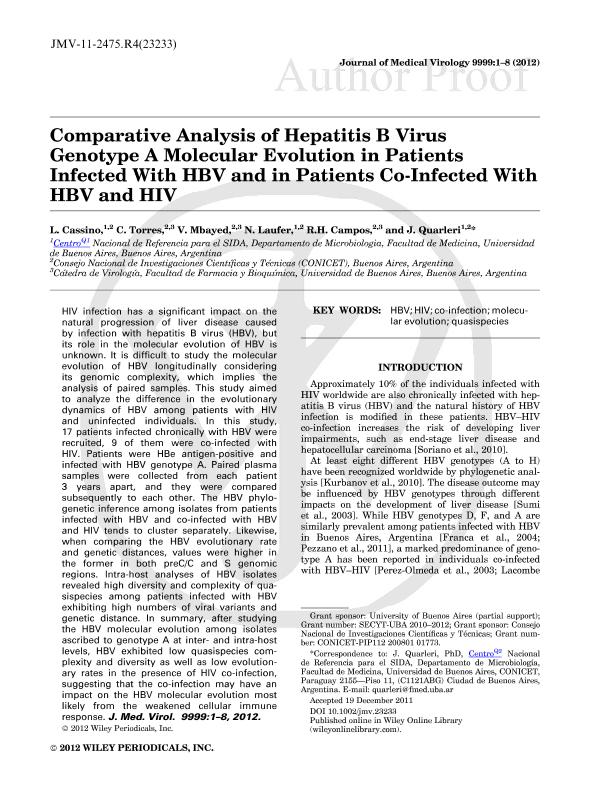Mostrar el registro sencillo del ítem
dc.contributor.author
Cassino, Lucila

dc.contributor.author
Torres, Carolina Cecilia

dc.contributor.author
Mbayed, Viviana Andrea

dc.contributor.author
Laufer, Natalia Lorna

dc.contributor.author
Campos, Rodolfo Hector

dc.contributor.author
Quarleri, Jorge Fabian

dc.date.available
2022-06-22T15:05:41Z
dc.date.issued
2012-04
dc.identifier.citation
Cassino, Lucila; Torres, Carolina Cecilia; Mbayed, Viviana Andrea; Laufer, Natalia Lorna; Campos, Rodolfo Hector; et al.; Comparative analysis of hepatitis B virus genotype a molecular evolution in patients infected with HBV and in patients co-infected with HBV and HIV; Wiley-liss, div John Wiley & Sons Inc.; Journal of Medical Virology; 84; 4; 4-2012; 562-569
dc.identifier.issn
0146-6615
dc.identifier.uri
http://hdl.handle.net/11336/160211
dc.description.abstract
HIV infection has a significant impact on the natural progression of liver disease caused by infection with hepatitis B virus (HBV), but its role in the molecular evolution of HBV is unknown. It is difficult to study the molecular evolution of HBV longitudinally considering its genomic complexity, which implies the analysis of paired samples. This study aimed to analyze the difference in the evolutionary dynamics of HBV among patients with HIV and uninfected individuals. In this study, 17 patients infected chronically with HBV were recruited, 9 of them were co-infected with HIV. Patients were HBe antigen-positive and infected with HBV genotype A. Paired plasma samples were collected from each patient 3 years apart, and they were compared subsequently to each other. The HBV phylogenetic inference among isolates from patients infected with HBV and co-infected with HBV and HIV tends to cluster separately. Likewise, when comparing the HBV evolutionary rate and genetic distances, values were higher in the former in both preC/C and S genomic regions. Intra-host analyses of HBV isolates revealed high diversity and complexity of quasispecies among patients infected with HBV exhibiting high numbers of viral variants and genetic distance. In summary, after studying the HBV molecular evolution among isolates ascribed to genotype A at inter- and intra-host levels, HBV exhibited low quasispecies complexity and diversity as well as low evolutionary rates in the presence of HIV co-infection, suggesting that the co-infection may have an impact on the HBV molecular evolution most likely from the weakened cellular immune response.
dc.format
application/pdf
dc.language.iso
eng
dc.publisher
Wiley-liss, div John Wiley & Sons Inc.

dc.rights
info:eu-repo/semantics/openAccess
dc.rights.uri
https://creativecommons.org/licenses/by-nc-sa/2.5/ar/
dc.subject
CO-INFECTION
dc.subject
HBV
dc.subject
HIV
dc.subject
MOLECULAR EVOLUTION
dc.subject
QUASISPECIES
dc.subject.classification
Virología

dc.subject.classification
Ciencias Biológicas

dc.subject.classification
CIENCIAS NATURALES Y EXACTAS

dc.title
Comparative analysis of hepatitis B virus genotype a molecular evolution in patients infected with HBV and in patients co-infected with HBV and HIV
dc.type
info:eu-repo/semantics/article
dc.type
info:ar-repo/semantics/artículo
dc.type
info:eu-repo/semantics/publishedVersion
dc.date.updated
2022-05-12T06:28:59Z
dc.identifier.eissn
1096-9071
dc.journal.volume
84
dc.journal.number
4
dc.journal.pagination
562-569
dc.journal.pais
Estados Unidos

dc.journal.ciudad
New York
dc.description.fil
Fil: Cassino, Lucila. Universidad de Buenos Aires. Facultad de Medicina. Departamento de Microbiología; Argentina. Consejo Nacional de Investigaciones Científicas y Técnicas. Oficina de Coordinación Administrativa Houssay; Argentina
dc.description.fil
Fil: Torres, Carolina Cecilia. Universidad de Buenos Aires. Facultad de Farmacia y Bioquímica. Departamento de Microbiología, Inmunología y Biotecnología. Cátedra de Virología; Argentina. Consejo Nacional de Investigaciones Científicas y Técnicas. Oficina de Coordinación Administrativa Houssay; Argentina
dc.description.fil
Fil: Mbayed, Viviana Andrea. Universidad de Buenos Aires. Facultad de Farmacia y Bioquímica. Departamento de Microbiología, Inmunología y Biotecnología. Cátedra de Virología; Argentina. Consejo Nacional de Investigaciones Científicas y Técnicas. Oficina de Coordinación Administrativa Houssay; Argentina
dc.description.fil
Fil: Laufer, Natalia Lorna. Universidad de Buenos Aires. Facultad de Medicina. Departamento de Microbiología; Argentina. Consejo Nacional de Investigaciones Científicas y Técnicas. Oficina de Coordinación Administrativa Houssay; Argentina
dc.description.fil
Fil: Campos, Rodolfo Hector. Universidad de Buenos Aires. Facultad de Farmacia y Bioquímica. Departamento de Microbiología, Inmunología y Biotecnología. Cátedra de Virología; Argentina. Consejo Nacional de Investigaciones Científicas y Técnicas; Argentina
dc.description.fil
Fil: Quarleri, Jorge Fabian. Consejo Nacional de Investigaciones Científicas y Técnicas. Oficina de Coordinación Administrativa Houssay; Argentina. Universidad de Buenos Aires. Facultad de Medicina. Departamento de Microbiología; Argentina
dc.journal.title
Journal of Medical Virology

dc.relation.alternativeid
info:eu-repo/semantics/altIdentifier/url/https://onlinelibrary.wiley.com/doi/10.1002/jmv.23233
dc.relation.alternativeid
info:eu-repo/semantics/altIdentifier/doi/http://dx.doi.org/10.1002/jmv.23233
Archivos asociados
